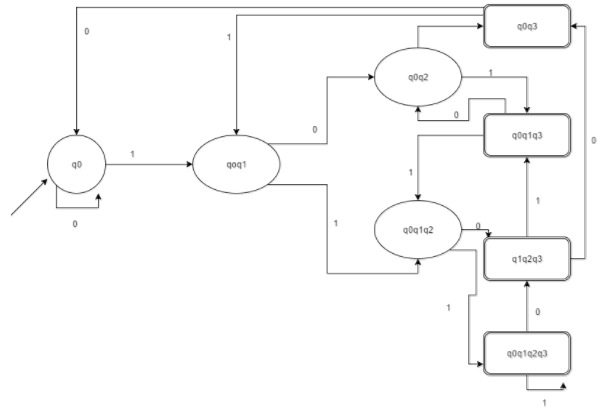This set of Automata Theory Multiple Choice Questions & Answers (MCQs) focuses on “Extended Transition Function”.
1. The number of tuples in an extended Non Deterministic Finite Automaton:
a) 5
b) 6
c) 7
d) 4
View Answer
Explanation: For NFA or extended transition function on NFA, the tuple elements remains same i.e. 5.
2. Choose the correct option for the given statement:
Statement: The DFA shown represents all strings which has 1 at second last position.

a) Correct
b) Incorrect, Incomplete DFA
c) Wrong proposition
d) May be correct
View Answer
Explanation: The given figure is an NFA. The statement contradicts itself.
3. What is wrong in the given definition?
Def: ({q0, q1, q2}, {0,1}, δ, q3, {q3})
a) The definition does not satisfy 5 Tuple definition of NFA
b) There are no transition definition
c) Initial and Final states do not belong to the Graph
d) Initial and final states can’t be same
View Answer
Explanation: q3 does not belong to Q where Q= set of finite states.
4. If δ is the transition function for a given NFA, then we define the δ’ for the DFA accepting the same language would be:
Note: S is a subset of Q and a is a symbol.
a) δ’ (S, a) =Upϵs δ (p, a)
b) δ’ (S, a) =Up≠s δ (p, a)
c) δ’ (S, a) =Upϵs δ(p)
d) δ’ (S) =Up≠s δ(p)
View Answer
Explanation: According to subset construction, equation 1 holds true.
5. What is the relation between DFA and NFA on the basis of computational power?
a) DFA > NFA
b) NFA > DFA
c) Equal
d) Can’t be said
View Answer
Explanation: DFA is said to be a specific case of NFA and for every NFA that exists for a given language, an equivalent DFA also exists.
6. If a string S is accepted by a finite state automaton, S=s1s2s3……sn where siϵ∑ and there exists a sequence of states r0, r1, r2…… rn such that δ(r(i), si+1) =ri+1 for each 0, 1, …n-1, then r(n) is:
a) initial state
b) transition symbol
c) accepting state
d) intermediate state
View Answer
Explanation: r(n) is the final state and accepts the string S after the string being traversed through r(i) other states where I ϵ 01,2…(n-2).
7. According to the given table, compute the number of transitions with 1 as its symbol but not 0:

a) 4
b) 3
c) 2
d) 1
View Answer
Explanation: The transition graph is made and thus the answer can be found.
8. From the given table, δ*(q0, 011) =?

a) {q0}
b) {q1} U {q0, q1, q2}
c) {q2, q1}
d) {q3, q1, q2, q0}
View Answer
Explanation: δ*(q0,011) = Urϵδ*(q0,01) δ (r, 1) = {q0, q1, q2}.
9. Number of times the state q3 or q2 is being a part of extended 6 transition state is

a) 6
b) 5
c) 4
d) 7
View Answer
Explanation: According to the question, presence of q2 or q1 would count so it does and the answer according to the diagram is 6.
10. Predict the missing procedure:

i.Δ(Q0, ε) ={Q0},
ii.Δ(Q0, 01) = {Q0, Q1}
iii.δ(Q0, 010) =?
a) {Q0, Q1, Q2}
b) {Q0, Q1}
c) {Q0, Q2}
d) {Q1, Q2}
View Answer
Explanation: According to given table and extended transition state implementation, we can find the state at which it rests.
Sanfoundry Global Education & Learning Series – Automata Theory.
To practice all areas of Automata Theory, here is complete set of 1000+ Multiple Choice Questions and Answers.
If you find a mistake in question / option / answer, kindly take a screenshot and email to [email protected]
- Check Automata Theory Books
- Practice Computer Science MCQs
- Check Computer Science Books
- Apply for Computer Science Internship
